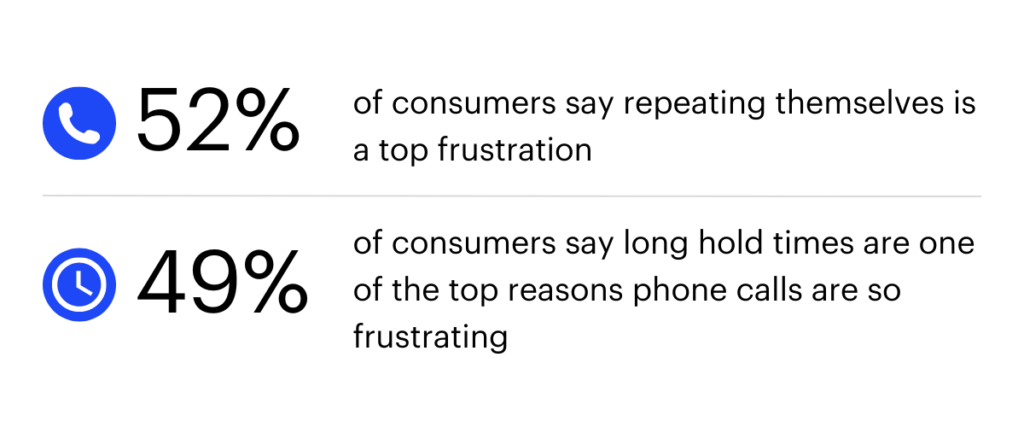Everything You Need To Know About Call Deflection
It’s a normal workday. Customer calls start coming in, and your team is soon overwhelmed. Wait times increase and customer satisfaction takes a hit. Pretty soon, the calls are so stacked and your employees can’t even remember what the first customer was calling about, leading to repetition and frustration. Your team is stuck on the phone, your customers are becoming increasingly dissatisfied, and time and resources are being wasted.
Regardless of the industry, most businesses have experienced such a scenario at one time or another. Modernizing your communication gives you a competitive edge and directs your time and resources to the places they will make the most impact, helping you grow your business. One key way to modernize is through effective call deflection.
With call deflection, businesses everywhere are breaking the boundaries of nine-to-five and doing so much more in less time. And we’re here to give you the scoop.
What is Call Deflection?
Call deflection is the strategy of reducing the number of customer calls your business, customer service center, or help desk receives by using alternative channels to answer customer questions. These can include digital and self-service channels. If your business (or contact center) typically receives a large number of low-impact calls, strategically diverting customer inquiries can be a real lifesaver.
Diverting calls can have a number of key benefits for your business, including:
- Reducing incoming calls
- Decreasing customer wait time
- Increasing customer satisfaction
- Freeing up customer service agents
- Increasing convenience
- Allowing employees to help multiple customers simultaneously
- Increasing business efficiency
- Optimizing your communications
- Lightening the load for your team
- Increasing consumer trust
Another key benefit is that if you use the right alternative channels, you can help customers get the answers they need more efficiently while keeping the human-like aspect of customer interaction that your business is known for. This significantly increases the quality of your customer experience. It also helps you meet the modern consumer where they’re at and avoid the common pitfalls of traditional calling and less effective channels.

With the vast variety of call deflection services available these days, understanding which channels will actually lead to increased convenience and satisfaction instead of robotlike, frustrating interaction is also important. You don’t want your customers to feel that you’re pushing their needs to the side under the guise of helping them. So, how do you decide which call deflection strategies will work best for your team? Let’s get into it.
Popular Call Deflection Strategies
When it comes to effectively deflecting calls, you want more than a phone tree or an optimized website. The key is to empower your customers and increase their autonomy while maintaining the personal feel of their interactions with your brand.
A critical element of this is understanding why callers are calling you. Analyzing caller intent can tell you which questions are most frequently asked and what information may not be readily available. Little changes based on caller intent analytics can go a long way in tightening any loose information patterns and increasing customer satisfaction.
Consider trying the most popular call deflection strategies businesses are currently adopting:
- Implement a live chat. Chat has become a critical element in the customer experience, and employees can easily and immediately handle multiple chats at the same time. Pro tip: The best type of chats are asynchronous, allowing you and your customer to ask and respond at different times from multiple interfaces. For example, Podium Webchat allows customers to contact your business through a chat feature and then continue the conversation by desktop or phone.
- Use messaging. Text messaging boasts a response rate 209% higher than phone calls, emails, or even Facebook. It’s also extremely cost-effective. According to a Forrester research report, a phone conversation costs around $15.50 per interaction vs. $1-$5 for 2-way text messaging. Keep in mind that offering your customers one-to-one communication through text can benefit more than call deflection. It can also offer opportunities for higher engagement throughout the entire customer journey—reducing phone calls while increasing response rates from customers.
- Combine voice and text. Connecting with the modern customer is all about making communication seamless and simple—essentially facilitating the most personalized level of communication with the least amount of effort required. While some customers might prefer to leave a voicemail, others might opt to send your business a text message—why not give customers both options and let them choose what works best for them? Another way you can combine the power of voice and text is by utilizing call forwarding. When your customers leave you a message, wouldn’t it be convenient to have that message stored in an internal dashboard so that the message doesn’t get lost? From there, your team can reach out via text message to follow up and make sure the customer gets the answers they were looking for.
As always, it’s vital to put yourself into the mind of your target customer and consider the nuances of your specific customer journey. Regardless of your industry, your customers love options. For the most effective call deflection, try a combination of call deflection strategies.
Call Deflection Saves You Time (and Money)
As a local business, we know you have almost no time to spare. Every minute is accounted for solving problems big and small—problems that sometimes seem to pop up out of nowhere. Making every second count is critical, and you don’t want your best employees locked on the phone trying to take care of a flood of low-impact calls. You want them doing what they do best and making an impact on the way your business operates.
Call deflection is your best friend because it saves you a significant amount of time—and money. Most of this has to do with efficiency. When calls are deflected to other channels, employees can usually handle more than one customer at a time. One study found that brands who transition to digital customer care can reduce costs by as much as 30%. Additionally, a better customer experience means happy customers, which results in free marketing (word-of-mouth), an increase in returning customers, and an increase in revenue.
Call Deflection Improves the Customer Experience
Of course, the real reason reducing call volume is so crucial is that it vastly improves your customer experience, eliminating fiction and saving your customers valuable time. Because returning customers, high reviews, and word-of-mouth marketing lead to revenue growth, improving your customer experience should always be a priority.
Did you know that 80% of consumers say a positive customer experience depends on speed, convenience, knowledgeable help, and friendly service? Brands that transition to digital customer care can also increase customer satisfaction by as much as 19%. Call deflection provides consumers with more self-service options and more freedom to craft a journey that will fit their situation best.
More importantly, directing customers to alternative channels helps customers get the answers they’re looking for almost immediately via desktop or mobile without having to be put on hold until one of your employees is available. No waiting means more five-star reviews.
Pro tip: Every couple of months, take stock of your call deflection rate—the rate at which your alternative channels and self-service tools are fulfilling the demand that would otherwise have been directed to phone calls. Checking this regularly will help you continually improve and maintain your customer experience.

Optimize Your Business Communications with Podium
Podium helps customers by offering the most effective call deflection tools, allowing you to provide a modern customer experience. With alternative service channels that help your employees and a plethora of self-service options, you’ll be able to provide the level of service your customers expect—all without breaking a sweat.

















